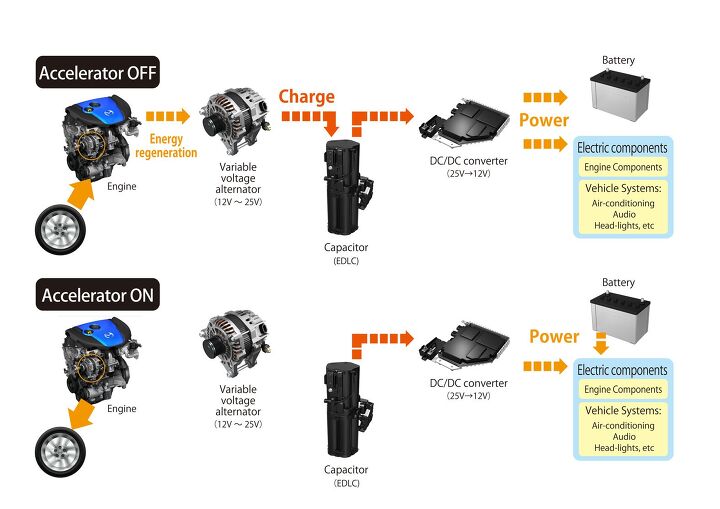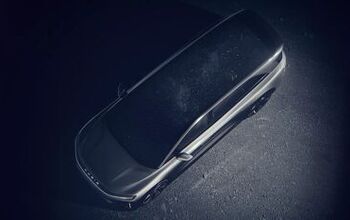Mazda Uses Capacitor To Save Gas

Toyota’s Chief Engineer Satoshi Ogiso figures that efficiency improvements of traditional gasoline engines may soon hit a wall. He gives the gasoline engine an improvement potential of “maybe 10 to 20 percent.” Today, we have proof that it is a fight of diminishing returns. Mazda is now at a point where it saves up to 10 percent of gas by idling the alternator. How is that done?
Mazda’s developed a regenerative braking system that uses a capacitor. Compared to batteries, a capacitor can be charged and discharged rapidly. Also, it does not wear out like a battery. Mazda stores the regenerated energy in the capacitor. It does not use it to power the car. That would need a hybrid system Mazda does not have. Also, even the new Electric Double Layer Capacitor (EDLC) Mazda uses would not get you far. Instead, Mazda uses the electricity to power the climate control, the audio system and other gizmos in the car that want electric power. As we know, the gizmos proliferate with abandon. And why does that save gas?
The electric power generated by the car’s alternator does not come free. The alternator demands power from the engine. As a rule of thumb, 5 hp are usually used, however, this changes with the amperage and type of the alternator.
Mazda calls its system “i-ELOOP.” It comes from “Intelligent Energy Loop.
The system uses a new 12-25V variable voltage alternator, a low-resistance electric double layer capacitor and a DC/DC converter. ‘i-ELOOP’ starts to recover kinetic energy the moment the driver lifts off the accelerator pedal and the vehicle begins to decelerate. The variable voltage alternator generates electricity at up to 25V for maximum efficiency before sending it to the Electric Double Layer Capacitor (EDLC) for storage. The capacitor can be fully charged in seconds. The DC/DC converter steps down the electricity from 25V to 12V before it is distributed directly to the vehicle’s electrical components. The system also charges the vehicle battery as necessary. Says Mazda:
“As a result, in ‘stop-and-go’ driving conditions, fuel economy improves by approximately 10 percent.”
The system will begin to appear in Mazda vehicles in 2012.
Mazda does not have hybrid technology and instead is betting on optimizing the ICE with Mazda’s Skyactiv Technology and other fuel saving tricks. As we see, the engineers have to get very creative to save a few more drops.

Bertel Schmitt comes back to journalism after taking a 35 year break in advertising and marketing. He ran and owned advertising agencies in Duesseldorf, Germany, and New York City. Volkswagen A.G. was Bertel's most important corporate account. Schmitt's advertising and marketing career touched many corners of the industry with a special focus on automotive products and services. Since 2004, he lives in Japan and China with his wife <a href="http://www.tomokoandbertel.com"> Tomoko </a>. Bertel Schmitt is a founding board member of the <a href="http://www.offshoresuperseries.com"> Offshore Super Series </a>, an American offshore powerboat racing organization. He is co-owner of the racing team Typhoon.
More by Bertel Schmitt
Latest Car Reviews
Read moreLatest Product Reviews
Read moreRecent Comments
- Jeff JMII--If I did not get my Maverick my next choice was a Santa Cruz. They are different but then they are both compact pickups the only real compact pickups on the market. I am glad to hear that the Santa Cruz will have knobs and buttons on it for 2025 it would be good if they offered a hybrid as well. When I looked at both trucks it was less about brand loyalty and more about price, size, and features. I have owned 2 gm made trucks in the past and liked both but gm does not make a true compact truck and neither does Ram, Toyota, or Nissan. The Maverick was the only Ford product that I wanted. If I wanted a larger truck I would have kept either my 99 S-10 extended cab with a 2.2 I-4 5 speed or my 08 Isuzu I-370 4 x 4 with the 3.7 I-5, tow package, heated leather seats, and other niceties and it road like a luxury vehicle. I believe the demand is there for other manufacturers to make compact pickups. The proposed hybrid Toyota Stout would be a great truck. Subaru has experience making small trucks and they could make a very competitive compact truck and Subaru has a great all wheel drive system. Chevy has a great compact pickup offered in South America called the Montana which gm could be made in North America and offered in the US and Canada. Ram has a great little compact truck offered in South America as well.
- Groza George I don’t care about GM’s anything. They have not had anything of interest or of reasonable quality in a generation and now solely stay on business to provide UAW retirement while they slowly move production to Mexico.
- Arthur Dailey We have a lease coming due in October and no intention of buying the vehicle when the lease is up.Trying to decide on a replacement vehicle our preferences are the Maverick, Subaru Forester and Mazda CX-5 or CX-30.Unfortunately both the Maverick and Subaru are thin on the ground. Would prefer a Maverick with the hybrid, but the wife has 2 'must haves' those being heated seats and blind spot monitoring. That requires a factory order on the Maverick bringing Canadian price in the mid $40k range, and a delivery time of TBD. For the Subaru it looks like we would have to go up 2 trim levels to get those and that also puts it into the mid $40k range.Therefore are contemplating take another 2 or 3 year lease. Hoping that vehicle supply and prices stabilize and purchasing a hybrid or electric when that lease expires. By then we will both be retired, so that vehicle could be a 'forever car'. And an increased 'carbon tax' just kicked in this week in most of Canada. Prices are currently $1.72 per litre. Which according to my rough calculations is approximately $5.00 per gallon in US currency.Any recommendations would be welcomed.
- Eric Wait! They're moving? Mexico??!!
- GrumpyOldMan All modern road vehicles have tachometers in RPM X 1000. I've often wondered if that is a nanny-state regulation to prevent drivers from confusing it with the speedometer. If so, the Ford retro gauges would appear to be illegal.


































Comments
Join the conversation
Alternators are only about 40% efficient at typical operating conditions. Even so I agree, 5 hp is a lot. Switch all the electrics off in your car at idle, note the fuel consumption on that handy little readout you never look at. Now switch everything on (not the AC). It'll bump up by maybe 0.04 gallons per hour. That ain't 5 hp.
Most of these "breakthroughs" seem to be expensive solutions to miniscule problems. The cost of all these systems just so you can put a less powerful alternator and save 1-2 horsepower from electricity production? To the average motorist, your talking pennies a week in saved fuel costs, only to be offset by thousands more tacked on to the cost of a new vehicle for such an elaborate system, and let's not even get started on what these dealer-only type repairs and parts are going to be in the future when they eventually wear out.